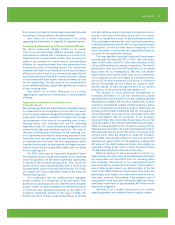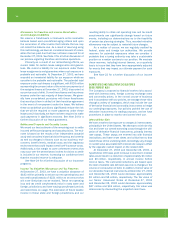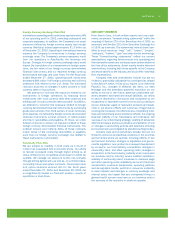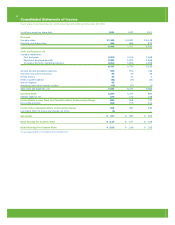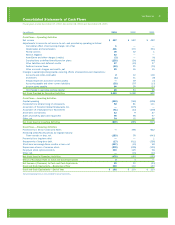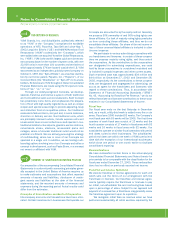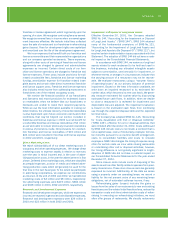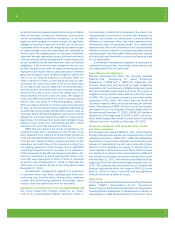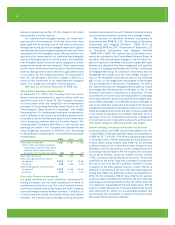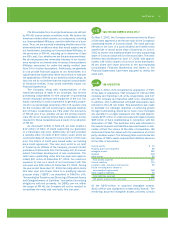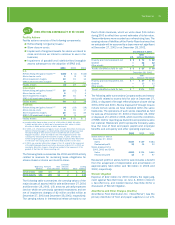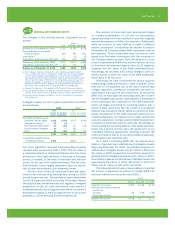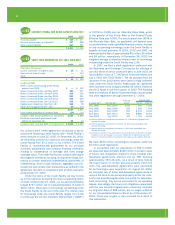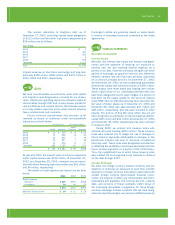Pizza Hut 2003 Annual Report Download - page 57
Download and view the complete annual report
Please find page 57 of the 2003 Pizza Hut annual report below. You can navigate through the pages in the report by either clicking on the pages listed below, or by using the keyword search tool below to find specific information within the annual report.
Yum! Brands Inc. 55.
rescission of FASB Interpretation No. 34” (“FIN 45”). FIN 45
elaborates on the disclosures to be made by a guarantor
in its interim and annual financial statements about its
obligations under guarantees issued. FIN 45 also clarifies
that a guarantor is required to recognize, at inception of
a guarantee, a liability for the fair value of certain obliga-
tions undertaken. The initial recognition and measurement
provisions were applicable to certain guarantees issued
or modified after December 31, 2002. While the nature of
our business results in the issuance of certain guarantees
from time to time, the adoption of FIN 45 did not have a
material impact on our Consolidated Financial Statements
for the year ended December 27, 2003.
We have also issued guarantees as a result of
assigning our interest in obligations under operating leases
as a condition to the refranchising of certain Company
restaurants. Such guarantees are subject to the require-
ments of SFAS No. 145, “Rescission of FASB Statements
No. 4, 44, and 64, Amendment of FASB Statement No. 13,
and Technical Corrections” (“SFAS 145”). We recognize a
liability for the fair value of such lease guarantees under
SFAS 145 at their inception, with the related expense being
included in refranchising gains (losses).
Cash and Cash Equivalents
Cash equivalents represent funds we have temporarily
invested (with original maturities not exceeding three
months) as part of managing our day-to-day operating cash
receipts and disbursements.
Inventories
We value our inventories at the lower of cost (computed on
the first-in, first-out method) or net realizable value.
Property, Plant and Equipment
We state property, plant and equipment at cost less
accumulated depreciation and amortization, impairment
writedowns and valuation allowances. We calculate depre-
ciation and amortization on a straight-line basis over the
estimated useful lives of the assets as follows: 5 to 25
years for buildings and improvements, 3 to 20 years for
machinery and equipment and 3 to 7 years for capitalized
software costs. As discussed above, we suspend deprecia-
tion and amortization on assets related to restaurants that
are held for sale.
Internal Development Costs and Abandoned Site Costs
We capitalize direct costs associated with the site acqui-
sition and construction of a Company unit on that site,
including direct internal payroll and payroll-related costs.
Only those site-specific costs incurred subsequent to the
time that the site acquisition is considered probable are
capitalized. If we subsequently make a determination that
a site for which internal development costs have been capi-
talized will not be acquired or developed, any previously
capitalized internal development costs are expensed and
included in general and administrative expenses.
Goodwill and Intangible Assets
The Company has adopted SFAS No. 141, “Business
Combinations” (“SFAS 141”). SFAS 141 requires the use
of the purchase method of accounting for all business
combinations and modifies the application of the purchase
accounting method. Goodwill represents the excess of the
cost of a business acquired over the net of the amounts
assigned to assets acquired, including identifiable intan-
gible assets, and liabilities assumed. SFAS 141 specifies
criteria to be used in determining whether intangible assets
acquired in a business combination must be recognized
and reported separately from goodwill. We base amounts
assigned to goodwill and other identifiable intangible assets
on independent appraisals or internal estimates.
The Company has also adopted SFAS No. 142,
“Goodwill and Other Intangible Assets” (“SFAS 142”).
SFAS 142 eliminates the requirement to amortize good-
will and indefinite-lived intangible assets, addresses the
amortization of intangible assets with a defined life, and
addresses impairment testing and recognition for goodwill
and indefinite-lived intangible assets. As a result of adopting
SFAS 142, we ceased amortization of goodwill and indefinite-
lived intangible assets beginning December 30, 2001. Prior
to the adoption of SFAS 142, we amortized goodwill on a
straight-line basis up to 20 years and indefinite-lived intan-
gible assets on a straight-line basis over 3 to 40 years. We
evaluate the remaining useful life of an intangible asset that
is not being amortized each reporting period to determine
whether events and circumstances continue to support an
indefinite useful life. If an intangible asset that is not being
amortized is subsequently determined to have a finite useful
life, we amortize the intangible asset prospectively over its
estimated remaining useful life. Amortizable intangible
assets continue to be amortized on a straight-line basis
over 3 to 40 years. As discussed above, we suspend amor-
tization on those intangible assets with a defined life that
are allocated to restaurants that are held for sale.
In accordance with the requirements of SFAS 142,
goodwill has been assigned to reporting units for
purposes of impairment testing. Our reporting units are
our operating segments in the U.S. (see Note 23) and
our business management units internationally (typically
individual countries). Goodwill impairment tests consist
of a comparison of each reporting unit’s fair value with
its carrying value. The fair value of a reporting unit is the
amount for which the unit as a whole could be sold in a
current transaction between willing parties. We generally
estimate fair value based on discounted cash flows. If the
carrying value of a reporting unit exceeds its fair value,
goodwill is written down to its implied fair value. We have
selected the beginning of our fourth quarter as the date
on which to perform our ongoing annual impairment test
for goodwill. For 2003, there was no impairment of goodwill
identified during our annual impairment testing. For 2002,
goodwill assigned to the Pizza Hut France reporting unit was


